Even though it’s a distant 11.9 billion kilometres away, Pioneer 10 is still coming in loud and clear. NASA scientists sent a message to the spacecraft from California using the agency’s Deep Space Network and received a reply just over 22 hours later at a dish in Spain. This communication occurred on the 30th anniversary of the spacecraft’s launch.
Hubble Gets New Solar Panels
Spacewalking astronauts spent their second day outside the space shuttle Columbia on Tuesday, adding a second new solar array to the Hubble Space Telescope. During the 7-hour, 16-minute spacewalk, astronauts James Newman and Michael Massimino also replaced one of the telescope’s stabilizing gyroscopes. The newly installed solar arrays are smaller than the telescope’s previous arrays, but they actually provide 20% more power. Three more spacewalks are still planned.
Columbia Links up With Hubble
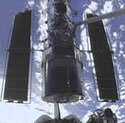
Image credit: NASA
Nearly 48 hours after launching from Cape Canaveral, the space shuttle Columbia caught up with the Hubble Space Telescope, grabbed it with the Canadarm and linked up. After the Sunday morning link up, the astronaut crew activated the motors that retract Hubble’s solar panels – unused since 1993, they performed flawlessly. Astronauts John Grunsfeld and Rick Linnehan will begin their first spacewalk on Monday to install new solar arrays.
The Hubble Space Telescope is secure in Columbia?s payload bay following its capture at 3:31 a.m. central time today, as the two spacecraft soared 350 miles above the Pacific Ocean southwest of the Mexican Coast.
Columbia?s chase of the telescope ended with Commander Scott Altman and Pilot Duane Carey manually flying Columbia to within 35 feet of Hubble allowing Mission Specialist Nancy Currie to use the shuttle?s robot arm to gently grasp the orbiting observatory.
With the telescope safely in the payload bay, the crew turned its attention to retracting the two large solar arrays that generate power for the telescope. The motors that drive the two arrays had not been used since the panels were originally deployed during the first servicing mission in December 1993. The motors performed flawlessly taking approximately five minutes to retract each of the two arrays. The retractions were scheduled to take place during orbital daytime to allow sunlight to adequately warm the arrays prior to retraction.
The first in a pair of new-generation solar arrays will be installed by John Grunsfeld and Rick Linnehan on the first scheduled spacewalk of the mission, which is set to begin about 12:30 a.m. Monday. However, it is possible the spacewalk could begin up to one hour earlier than scheduled.
The crew is scheduled to wake up about 8 p.m. today, and within hours Grunsfeld and Linnehan, with the assistance of crewmates Jim Newman and Mike Massimino, will begin donning their spacesuits. They will begin the spacewalk by setting up some of the tools they will use, before Grunsfeld and Linnehan, working together, remove the old array, stow it in the payload bay and install the new starboard side array. They will also install its associated electrical support components, called a Diode Box Assembly. Mission Control bid the crew goodnight just before noon today concluding a busy and successful day culminating with the capture of the Hubble Space Telescope. The next STS-109 mission status report will be issued Sunday evening following crew wake-up or as events warrant.
Original Source: NASA News Release
First Odyssey Photos Released
It’s only the first few photographs from Mars Odyssey, but scientists are already excited about what the spacecraft has turned up on the surface of Mars. Odyssey, which began mapping the planet last week, has detected significant amounts of hydrogen near the planet’s south pole. Scientists believe this hydrogen is evidence of water ice – and not just surface frost, but a large quantity of frozen water.
Initial science data from NASA’s Mars Odyssey spacecraft, which began its mapping mission last week, portend some tantalizing findings by the newest Martian visitor, including possible identification of significant amounts of frozen water.
“We are delighted with the quality of data we’re seeing,” said Dr. Steve Saunders, Odyssey project scientist at JPL. “We’ll use it to build on what we’ve learned from Mars Global Surveyor and other missions. Now we may actually see water rather than guessing where it is or was. And with the thermal images we are able to examine surface geology from a new perspective.”
“These preliminary Odyssey observations are the ‘tip of the iceberg’ of the science results that are soon to come, so stay tuned,” said Dr. Jim Garvin, lead scientist of the Mars Exploration Program at NASA Headquarters, Washington, D.C.
New images taken by the thermal emission imaging system show the temperature of the surface at a remarkable level of clarity and detail during both the martian day and night. The images can be seen at http://mars.jpl.nasa.gov/odyssey and http://themis.asu.edu/latest . Odyssey’s camera system is studying Mars’ surface mineralogy to reveal geologic history. The thermal infrared images are 30 times sharper than previously available images, and the camera’s visible-light images will fill a gap in resolution between Viking Orbiter and Mars Global Surveyor pictures.
Initial measurements by the gamma ray spectrometer instrument suite show the presence of significant amounts of hydrogen in the south polar region of Mars. The high hydrogen content is most likely due to water ice, though the amount of ice cannot be quantified yet. Further analysis will be conducted to confirm the interpretation. The detection of hydrogen is based both on the intensity of gamma rays emitted by hydrogen, and by the intensity of neutrons that are moderated by hydrogen. The neutron intensity was observed by the high energy neutron detector and the neutron spectrometer. Additional information is available online at http://grs.lpl.arizona.edu/results/presscon1/ .
“The preliminary assessment of the gamma-ray spectrometer data indicates the likely presence of hydrogen in the upper few feet of the martian surface as sampled at spatial scales approximately 400 miles across. Further analysis and another month or so of mapping will permit more quantitative assessment of these observations and allow for a refined interpretation,” said Garvin.
Measurements made by the martian radiation environment experiment during Odyssey’s cruise phase suggest that the daily dose of radiation experienced by astronauts on their way from Earth to Mars would be more than twice the dose endured by astronauts on the International Space Station. Investigators are in the process of troubleshooting the radiation experiment to determine why the instrument stopped communicating and was turned off in August 2001.
The Jet Propulsion Laboratory manages the 2001 Mars Odyssey mission for NASA’s Office of Space Science, Washington, D.C. Investigators at Arizona State University in Tempe, the University of Arizona in Tucson, and NASA’s Johnson Space Center, Houston, operate the science instruments. Additional science partners are located at the Russian Aviation and Space Agency, which provided the high-energy neutron detector, and at Los Alamos National Laboratories, New Mexico, which provided the neutron spectrometer. Lockheed Martin Astronautics, Denver, is the prime contractor for the project, and developed and built the orbiter. Mission operations are conducted jointly from Lockheed Martin and from JPL, a division of the California Institute of Technology in Pasadena.
Original Source: NASA News Release
Cooling Problem Threatens Shuttle Mission
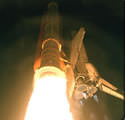
Image credit: NASA
Space shuttle managers are debating whether to end the space shuttle Columbia’s mission to upgrade the Hubble Space Telescope because one of its two cooling systems isn’t working properly. Although the shuttle is equipped with two redundant systems, NASA flight rules demand that the shuttle return to Earth if either completely fail – right now, one is just blocked and not working at full capacity. Mission controllers will make a decision to scrub the mission or keep going Friday evening.
Following Columbia?s on-time launch from the Kennedy Space Center this morning, flight controllers in Mission Control noticed a degraded flow rate in one of two freon cooling loops that help to dissipate heat from the orbiter.
There are two freon cooling loops that are part of the shuttle?s active thermal control system, one on the port and one on the starboard side of the payload bay. Freon loop 1 on the port side is showing a degraded flow rate.
While low, the flow rate is slightly above flight rule limits. Mission managers are currently reviewing the flight data and studying the past performance of the sensors that measure the flow rate of the freon through the loops to build confidence in the performance of the freon loop and its ability to support the STS-109 mission through completion.
After reaching orbit this morning, Commander Scott Altman and Pilot Duane Carey commanded the first in a series of engine firings to position Columbia for its Sunday morning rendezvous with the Hubble Space Telescope. Their crew mates ? Mission Specialists John Grunsfeld, Mike Massimino, Nancy Currie, Jim Newman and Rick Linnehan ? began readying Columbia for its on-orbit operations by stowing away their launch and entry suits and opening the interior hatch to Columbia?s airlock.
This is Columbia?s first flight since July 1999, following an extensive modification period in which many of its systems were replaced or enhanced. Columbia was NASA?s first shuttle orbiter and flew for the first time in April 1981.
The next status report will be issued following the crew?s scheduled wake-up call at 8:22 p.m., or as events warrant.
Original Source: NASA News Release
Jupiter is Buffeted by Solar Wind
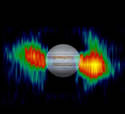
Image credit: NASA
Scientists have uncovered the workings of an invisible bubble of charged particles that surround Jupiter and interact with the solar wind. This bubble is called the magnetosphere and extends to a distance of 100 times the diameter of Jupiter itself. 14 months ago, two spacecraft: Galileo and Cassini took simultaneous readings of the giant planet’s magnetosphere from different vantage points. Detailed results of their findings will be published in scientific journals in the next few days.
Scientists simultaneously using a combination of NASA spacecraft have seen into the workings of an invisible whirling bubble of charged particles surrounding Jupiter.
That bubble, Jupiter’s magnetosphere, is the biggest object with distinct boundaries within our solar system, more than 100 times wider than Jupiter itself. It contracts in response to shock waves from the Sun, according to one report appearing in the journal Nature tomorrow. In all, seven reports appearing together will detail various results from a concerted research campaign that took advantage of the Saturn-bound Cassini spacecraft’s flyby of Jupiter 14 months ago.
The campaign found extremely energetic electrons traveling near the speed of light close to Jupiter, as well as a vast nebula of neutral atoms, and triggers for glowing auroras near Jupiter’s north and south poles.
“We’re seeing results from a remarkable opportunity,” said Dr. Scott Bolton, a physicist at NASA’s Jet Propulsion Laboratory, Pasadena, Calif., and a co-author of three of the reports.
“We had one spacecraft, Galileo, inside the magnetosphere monitoring what was happening there at the same time another spacecraft, Cassini, was outside the magnetosphere monitoring the solar wind just upstream,” Bolton said. The solar wind is particles from the Sun flowing outward through the solar system. Jupiter’s magnetosphere, like Earth’s, deflects the solar wind but gets pushed around by its gusts.
On Jan. 10, 2001, when Cassini and Galileo were more than 20 times farther from each other than Earth is from the Moon, each spacecraft encountered the boundary of Jupiter’s magnetosphere while the bubble was contracting in response to an increase in solar-wind pressure.
“This is the first two-point measurement of the Jovian system actually responding to the solar wind,” said Dr. William Kurth, physicist at the University of Iowa, Iowa City, and lead author of the Nature report on these results. “The combined observations of Galileo and Cassini help show us the relative importance of the influence of the solar wind and the factors affecting the magnetosphere from within — primarily the energy from Jupiter’s rotation and the supply of material from volcanoes on the moon Io.” The Jupiter observations strengthen confidence in our understanding about Earth’s protective magnetosphere.
Shock waves from outbursts on the Sun, carried outward on the solar wind and detected by Cassini, also stimulated radio emissions from deep within Jupiter’s magnetosphere and brightened auroras at Jupiter’s poles, Dr. Donald Gurnett of the University of Iowa reports. Those effects suggest that electron density and electric currents in the magnetosphere increase when it is compacted by the shock wave.
Besides Galileo, which has been orbiting Jupiter since 1995, and Cassini, scientists used two Earth orbiters — the Hubble Space Telescope and Chandra X-ray Observatory ? plus radio telescopes in New Mexico and Arizona to examine Jupiter’s surroundings while Cassini was there.
Hubble images show patches of Jupiter’s aurora stimulated by an event Galileo detected within the magnetosphere, reports Dr. Barry Mauk of Johns Hopkins University’s Applied Physics Laboratory, Laurel, Md. The event is a surge of charged particles toward the planet, apparently analogous to similar aurora-triggering surges that release pent-up energy in Earth’s magnetosphere. Some other features in Jupiter’s aurora are “footprints” of currents flowing through the magnetosphere from three of the planet’s large moons, reports Dr. John Clarke of Boston University. Dr. Randall Gladstone of the Southwest Research Institute, San Antonio, Texas, describes a 45-minute rhythm in auroras at X-ray wavelengths, likely linked to a still-unidentified stimulus in the outer portion of the magnetosphere.
Cassini carries a type of magnetosphere-imaging instrument no previous interplanetary spacecraft has had. The instrument not only showed some structural detail of Jupiter’s magnetosphere, it also detected a cloud of neutral atoms stretching away from the planet as a “hot neutral wind,” reports Dr. Stamatios Krimigis of Hopkins’ Applied Physics Laboratory. The magnetic field holds charged particles in, but neutral ones escape to create a nebula of particles that extends beyond the magnetosphere.
High-energy electrons in radiation belts close to Jupiter emit radio waves that have been monitored from Earth for years. JPL’s Bolton and other scientists used Cassini while it was near Jupiter to map details never seen before in those belts. About 2,300 students at high schools and middle schools across the country participated in a program of radio-telescope observations that aided interpretation of those Cassini observations.
Cassini is a cooperative project of NASA, the European Space Agency and the Italian Space Agency. JPL manages Cassini and Galileo for NASA?s Office of Space Science, Washington, D.C. JPL is a division of the California Institute of Technology in Pasadena.
Original Source: NASA/JPL News Release
Shuttle on its Way to Upgrade Hubble
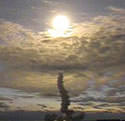
Image credit: NASA
The space shuttle Columbia roared into the Florida sky Friday morning, beginning an 11-day mission to upgrade the Hubble Space Telescope. The mission had originally been delayed a day because of unusually chilly weather, but everything was “go for launch” this morning. Columbia lifted off at 1122 GMT (6:22am EST) and is scheduled to meet up with the telescope early Sunday morning.
With the Hubble Space Telescope orbiting high overhead, the shuttle Columbia lifted off this morning on a complex mission to replace and upgrade key telescope systems through five challenging spacewalks.
Commander Scott Altman, Pilot Duane Carey, Flight Engineer Nancy Currie and spacewalkers John Grunsfeld, Rick Linnehan, Jim Newman and Mike Massimino blasted off of Launch Pad 39-A at the Kennedy Space Center at 5:22 a.m. Central time as Hubble orbited just west of Sarasota, Florida at an altitude of about 360 miles. Because of its brightness and elevation, the telescope was visible in the pre-dawn sky over the launch site as Columbia began its pursuit.
Less than nine minutes later, the pioneer shuttle was in orbit for the first time since July 1999, following an extensive modification period in which many of its systems were replaced and enhanced.
Columbia began a two-day chase to reach Hubble for its fourth service call, in which the observatory?s solar arrays, main power switching unit, and a gyroscopic pointing mechanism will be replaced by newer components. In addition, the spacewalkers will also install a new scientific instrument ten times more powerful than the Hubble?s Wide Field Planetary Camera to survey the universe and will attempt to restore an infrared instrument through the installation of a cooling system and an external radiator.
If all goes as planned, Currie will use Columbia?s robot arm to grapple Hubble shortly after 3 a.m. CST on Sunday, setting the stage for five consecutive days of servicing spacewalks beginning early Monday morning.
Columbia?s crew will spend the next few hours unpacking equipment, setting up computers and conducting the first of periodic engine firings that will occur over the next two days to refine the shuttle’s approach to Hubble. The shuttle crew will begin its first sleep period at 12:22 p.m. CST and will be awakened at 8:22 p.m. this evening to begin its first full day in orbit, designed to test the ship?s robot arm, spacesuits and rendezvous equipment which will be used over the next few days.
The next STS-109 mission status report will be issued Friday evening after Columbia?s crew is awakened.
Original Source: NASA News Release
Ariane 5 Launches Envisat Successfully
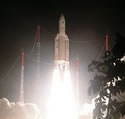
Image credit: Arianespace
After much anticipation, an Ariane 5 rocket blasted off from Kourou, French Guiana last night, carrying the European Space Agency’s Envisat environmental monitoring satellite into an 800km orbit. Once it reaches its final orbit, the 8000 kg Envisat will observe the Earth’s environment using ten instruments which measure the state of the land, ocean, ice cover and atmosphere. This is the first launch of an Ariane 5 since a problem last July that placed two satellites into incorrect orbits.
The eagerly awaited launch of ESA?s Envisat environmental monitoring satellite took place in Kourou, French Guiana, today at 22:07:59 hrs Kourou time (02:07:59 hrs CET). Envisat?s spectacular night-time launch also marked the return to business for Europe?s Ariane 5 launcher.
Lift-off was witnessed by dozens of cheering engineers, scientists and project members at the launch site and at ESA centres across Europe. Rising into a clear sky, the Ariane 5 propelled the Envisat towards a lofty vantage point some 800 km above the Earth?s surface.
Envisat ? the most ambitious Earth observation satellite ? follows in the footsteps of ESA?s successful ERS-1 and ERS-2 missions launched in the 1990s. It will boost Europe?s capacity to take part in the study of the Earth and its environment by supporting critical research programmes on global warming and climate change issues, as well as performing crucial tasks such as pollution and disaster monitoring .
After a flawless lift-off, the Ariane 5 placed Envisat into sun-synchronous orbit, allowing ESA ground controllers at the space operations centre in Darmstadt, Germany, to take full control for the first time of the most complex satellite ever built in Europe.
?This has been a particularly exciting day for ESA and the European space community as a whole,? said Jos? Achache, ESA?s Director of Earth Observation. ?Europe is taking an important lead in global observations for worldwide environmental needs and Envisat is going to make a significant impact on the future of remote sensing of the Earth?.
?The ten instruments on board Envisat, more than on any other satellite, cover a wide spectrum of phenomena, delivering evidence of the interactions between the atmosphere, the ocean, the polar ice caps, the vegetation as well as human activity at the surface of the Earth. We will be able to trace the smallest changes to the Earth?s surface anywhere on the globe. The importance of this mission has triggered great interest in the Earth-science community, both at a European level and worldwide.?
Commenting from Europe?s spaceport in French Guiana, Jacques Louet, ESA?s Envisat Programme Manager, admitted that there was a certain risk to pack so much know-how into just one satellite. ?However, if we want to have a comprehensive understanding, we must follow this path?, he said.
Given its sheer size, Envisat has involved almost all of Europe?s space industries in the development of numerous advanced technologies, particularly for the payload.
Envisat is expected to be declared operational after just a few weeks, once its payload has been checked out and the various data-recovery links set up. Then the satellite?s six-month long commissioning phase will begin, ensuring that the ten instruments are operating as specified and that we can start delivering validated products to our users.
?Now Envisat is in orbit, the culmination of many years? work really begins and we are looking forward to the environmental benefits the satellite is going to bring to Europe,? added Mr Achache.
The successful launch of Envisat also marked a return to service for the Ariane 5 launcher. It?s upper stage has undergone over 300 tests since last summer, following the failure of flight Ariane 510 to insert two satellites, including ESA?s Artemis, in the correct orbits. However, thanks to ion propulsion, the Artemis mission is turning into a success story, as the satellite is making its way to geostationary orbit, and nominal operations could start this summer.
Original Source: ESA News Release
Jupiter’s X-Ray Hotspot Puzzles Astronomers
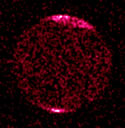
Image credit: Chandra
A new image taken by the Chandra X-Ray Telescope shows puzzling, pulsating hotspots at Jupiter’s north and south poles. So far, scientists have no explanation for what could be causing these X-rays; although, they do coincide with other phenomena seen on the planet, including auroras; like those at the Earth’s poles.
This image of Jupiter shows concentrations of auroral X-rays near the north and south magnetic poles. While Chandra observed Jupiter for its entire 10-hour rotation, the northern auroral X-rays were discovered to be due to a single ‘hot spot’ that pulsates with a period of 45 minutes, similar to high-latitude radio pulsations previously detected by NASA’s Galileo and Cassini spacecraft.
Although there had been prior detections of X-rays from Jupiter with other X-ray telescopes, no one expected that the sources of the X-rays would be located so near the poles. The X-rays are thought to be produced by energetic oxygen and sulfur ions that are trapped in Jupiter’s magnetic field and crash into its atmosphere. Before Chandra’s observations, the favored theory held that the ions were mostly coming from regions close to the orbit of Jupiter’s moon, Io.
Chandra’s ability to pinpoint the source of the X-rays has cast serious doubt on this model. Ions coming from near Io’s orbit cannot reach the observed high latitudes. The energetic ions responsible for the X-rays must come from much further away than previously believed.
One possibility is that particles flowing out from the Sun are captured in the outer regions of Jupiter’s magnetic field, then accelerated and directed toward its magnetic pole. Once captured, the ions would bounce back and forth in the magnetic field, from Jupiter’s north pole to south pole in an oscillating motion that could explain the pulsations.
Original Source: Chandra News Release
NASA Tries to Contact Pioneer 10
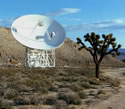
Image credit: NASA
Later this week, NASA scientists will attempt to contact the distant Pioneer 10 spacecraft, which was launched 30 years ago. The team will try to reach the spacecraft by focussing a radio telescope at the Jet Propulsion Laboratory?s Deep Space Network (DSN) in Madrid, Spain. Launched on March 2, 1972, Pioneer 10 is now 11.9 billion kilometres away from the Earth and hasn’t been heard from since April 2001.
NASA scientists will try to contact Pioneer 10 this week to see if the plucky little spacecraft?s signal can still be heard ? 30 years after its launch.
On March 2, 2002, scientists operating a radio telescope at the Jet Propulsion Laboratory?s Deep Space Network (DSN) in Madrid, Spain, will attempt to duplicate the feat they accomplished last spring, when they successfully established contact with the spacecraft after a silence of eight months.
“We?re going to try again this year to see if Pioneer 10 still lives on,” said Pioneer 10 Flight Director David Lozier of NASA Ames Research Center, located in the heart of California?s Silicon Valley. “We are hopeful that the successful contacts with the spacecraft that we had last year will be repeated this year.”
NASA made contact with the spacecraft in April of last year. It was the first time the spacecraft had been heard from since the previous summer.
“We had been listening for the Pioneer 10 signal with no success,” recalled Pioneer 10 Project Manager Dr. Larry Lasher of Ames. “So we felt that in order for Pioneer 10 to talk to us, we might need to talk to it.
“We sent up a signal on April 27, 2001, and on April 28, 2001 – 22 hours later, the time it took for the two-way signal to return ? there it was, right on time; it came in loud and clear and strong,” said Lasher. Since then, the scientists have successfully contacted the spacecraft twice more, most recently on July 9, 2001.
Launched on March 2, 1972, Pioneer 10, built by TRW Inc., Redondo Beach, Calif., is now at a distance of 7.4 billion miles from Earth. Pioneer 10 was the first spacecraft to pass through the asteroid belt and the first to make direct observations and obtain close-up images of Jupiter. During the passage by Jupiter, Pioneer 10 also charted Jupiter?s intense radiation belts, located the planet?s magnetic field, and established that Jupiter is predominantly a liquid planet.
In 1983, it became the first man-made object to leave the solar system when it passed the orbit of the most distant planet. The spacecraft continued to make valuable scientific investigations in the outer regions of the solar system until its science mission ended on March 31, 1997. Pioneer 10?s weak signal continues to be tracked by DSN as part of an advanced concept study of communications technology. Pioneer 10 is headed toward the constellation Taurus (the Bull), where it will pass the nearest star in the constellation in about two million years.
“Pioneer 10 has performed much better than expected,” said Robert Hogan, chief of Ames? Space Projects Division where the Pioneer project is managed. “It?s amazing that it?s lasted this long,” added Hogan, who is also a member of the original launch team for the spacecraft.
Scientists continue to analyze data received from Pioneer 10?s Geiger-Tube Telescope instrument operated by principal investigator Dr. James Van Allen of the University of Iowa. Based on the data received, Van Allen concluded that cosmic-ray intensity has continued to decrease. According to Van Allen, Pioneer 10 is still under the delayed influence of solar activity and has not yet reached the cosmic ray modulation boundary of the heliosphere. Scientists say knowledge of this boundary will help define the edge of the solar system, the location where the outermost boundary of the solar system meets interstellar space.
Original Source: NASA News Release
